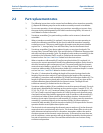
18 Steps to remove a transducer assembly from a meter while the meter is under line pressure
Section 4: Removing a transducer assembly Operation Manual
September 2013 3-9000-744 Rev F
d. Attach extractor tool piston assembly (P) to lubricator chamber assembly (M) by
aligning the extractor tool piston assembly (P) end bolts with the lubricator
chamber assembly (M) flange bolt holes. During this assembly insert the
extractor rod (N) into the center hole of the piston of the extractor tool piston
assembly (P). If it is necessary to move the piston to allow assembly, push the
piston against the extractor rod (N). During this process the air within the piston
cylinder must be vented through the piston orifice fitting (Y) so movement will
be slow. Install and tighten the four nuts (X). Minimize the rotation of the
extractor tool assembly during nut tightening.
e. Connect the quick connect body (BB) on the end of the low pressure hose
attached to the extractor tool piston assembly (P) to the quick connect stem
(DD) on the low pressure (secondary) port of the pressure regulator (V).
f. Fully loosen the pressure regulator (V) adjustment screw.
g. Close the lubricator chamber vent valve (R). The extractor tool valve assembly (H)
must remain in the full open position.
5. Refer to Drawing D-08248 (Appendix C).
a. Install the meter housing quick connect stem (FF) to the ultrasonic meter
housing line pressure valve (Q). If required, use the reducer provided with the
tool kit.
b. Connect the quick connect body (AA) on one end of the high pressure hose to
the quick connect stem (FF) on the ultrasonic meter housing line pressure valve
(Q) - Customer Supplied - (Refer to Appendix C - Drawings, note Q typical).
HIGH PRESSURE HAZARD
The ultrasonic meter housing line pressure valve (Q) is to remain closed until both ends of
the high pressure hose are securely connected.
Failure to keep the valve closed until the ends of the hose are securely connected may result in
personal injury from explosive forces.


















